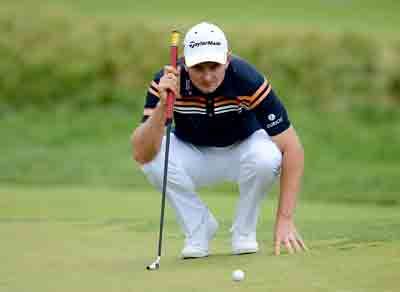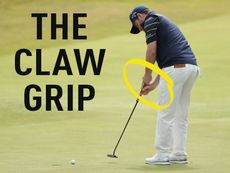Justin Rose: my putting secrets
Justin Rose, the 2013 US Open champion, gives his tips to better putting and avoiding three-putts in this exclusive instruction interview


Justin Rose, the 2013 US Open champion, gives his tips to better putting and avoiding three-putts in this exclusive instruction interview
Rose's putting tips:
1) Pace control
Last year I made nothing outside 15ft so in the off-season I spent a lot of time working on improving my speed control. If the ball is rolling at the hole at the right speed, the hole is bigger. Also, if your natural feel for speed is good you'll avoid three-putting, which is obviously one of the most annoying ways to drop a shot. I think it's important to be creative with your practice. For instance, I like to set a string line 15ft away from me and another string line at 20ft. How many putts can you hit that finish in the 5ft window? Another great way to develop feel is to hit putts with your eyes closed, only lifting your head and opening your eyes when you think the ball has stopped rolling.
2) Knowing your stroke
Get the Golf Monthly Newsletter
Subscribe to the Golf Monthly newsletter to stay up to date with all the latest tour news, equipment news, reviews, head-to-heads and buyer’s guides from our team of experienced experts.
It is easy to lose your feel if you get too caught up in the mechanics of your stroke. The advice I've had from great putters like Brad Faxon, Mark McNulty and Ben Crenshaw has been not to copy anyone else. Make your own stroke at your own rhythm. Rhythm is the most important thing in putting. Often when you putt poorly it's not because of your alignment or stroke path, it's because your rhythm is off.
3) Rhythm under pressure
This is part of a bigger conversation about how rhythm can affect everything - your driving, your iron play and even the speed at which you walk. Be aware of it. We all have a tendency to grip the putter too tightly when the pressure is on. Tension in the body is the reason why your rhythm can change. Recognise that this can happen under pressure and try to keep tension from taking hold.
4) Stroke mechanics
Technically, I think the putter has to swing on an arc because you are standing to the side of the ball. The more vertical you get the shaft angle, the more square-to-square the stroke will be - the chest-length putter is a good example of that. But if the putter shaft is at an angle, it has to arc. Clearly the face has to be square at impact. The path of the putter does not affect the start line anywhere near as much as face angle. Unlike if you swing across the ball with a driver and hit a slice, if do the same with a putter but the face is square at impact, the ball will pretty much start on line.
5) Importance of routine
I changed my routine back in 2007. That was my best putting year and I went on to win the Order of Merit. I'd read the putt, use the line on the ball to aim it, then take one practice swing, feel the putt going in and then step up and trust it.
6) Good putts, bad results
Do what you can to give yourself the best chance of making the putt and then concentrate on making a good stroke. Dave Pelz has done some tests where he rolls a ball the same way 10 times and not every ball goes in the hole. There are vagaries to putting that we all have to accept.
7) Straight putts
People often say that straight putts are hard to read, but I think the problem is that you need to be more precise. Speed is less of a factor because there is no break so your alignment becomes more important. If you have a putt that breaks two cups right, there's a host of different lines you can pick depending on the pace you choose. Generally, I like to die the ball into the hole and if I play foursomes with Ian Poulter, we will read the same putt differently because we have a different feel for pace.
8) Pressure putts
Blocking out the magnitude of a pressure situation requires you to focus on the process, keep your head still and take the value out of the putt. By that I mean try not to get caught up in the result. Just concentrate on making as good a stroke as possible. If you start guiding the ball in, or you look up too soon, that's when things go wrong.
9) Watch Snedeker
I like watching Brandt Snedeker on the greens as he's got a natural fluidity about the way he does everything. I've talked to him about his putting and it's interesting because he doesn't read his putts too precisely. He thinks, ‘I'll hit this one outside the right edge'. It's quite vague but I think that creates a freedom. He doesn't see lines, but to be honest neither do I, as I prefer to pick a spot and aim for that. I think that's why I putt better on bent grass greens, as there you see the odd spot. I also love watching Luke Donald; he has great rhythm and speed control. He does a lot of speed drills and his three-putt avoidance is fantastic.

Nick Bonfield joined Golf Monthly in 2012 after graduating from Exeter University and earning an NCTJ-accredited journalism diploma from News Associates in Wimbledon. He is responsible for managing production of the magazine, sub-editing, writing, commissioning and coordinating all features across print and online. Most of his online work is opinion-based and typically centres around the Majors and significant events in the global golfing calendar. Nick has been an avid golf fan since the age of ten and became obsessed with the professional game after watching Mike Weir and Shaun Micheel win The Masters and PGA Championship respectively in 2003. In his time with Golf Monthly, he's interviewed the likes of Rory McIlroy, Justin Rose, Jose Maria Olazabal, Henrik Stenson, Padraig Harrington, Lee Westwood and Billy Horschel and has ghost-written columns for Westwood, Wayne Riley, Matthew Southgate, Chris Wood and Eddie Pepperell. Nick is a 12-handicap golfer and his favourite courses include Old Head, Sunningdale New, Penha Longha, Valderrama and Bearwood Lakes. If you have a feature pitch for Nick, please email nick.bonfield@futurenet.com with 'Pitch' in the subject line. Nick is currently playing: Driver: TaylorMade M1 Fairway wood: TaylorMade RBZ Stage 2 Hybrid: Ping Crossover Irons (4-9): Nike Vapor Speed Wedges: Cleveland CBX Full Face, 56˚, Titleist Vokey SM4, 60˚ Putter: testing in progress! Ball: TaylorMade TP5x
-
 'Gator Netting Is In Place' - Chevron Championship Venue Prepared For 'Safe' Winner's Jump
'Gator Netting Is In Place' - Chevron Championship Venue Prepared For 'Safe' Winner's JumpA tradition which began at the tournament's previous home could continue this year - if the champion is feeling brave enough...
By Jonny Leighfield Published
-
 New Balance 997 SL Golf Shoe Review
New Balance 997 SL Golf Shoe ReviewNew Balance produce some extremely stylish footwear and, in this review, Matt Cradock takes their spikeless 997 SL onto the course
By Matt Cradock Published
-
 Claw Grip Putting Technique Analysis
Claw Grip Putting Technique AnalysisGM Top 25 coach Ged Walters looks at the claw grip and, specifically, how Branden Grace uses it to good effect
By Golf Monthly Published
-
 Justin Rose: how to win under pressure
Justin Rose: how to win under pressureJustin Rose, the 2013 US Open champion, reveals his keys to staying calm and composed under pressure
By Nick Bonfield Published